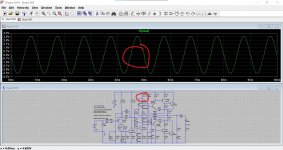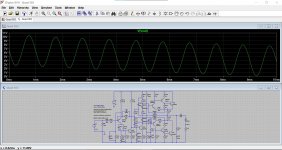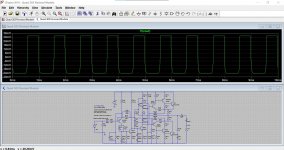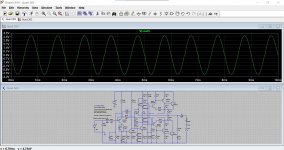No cap connected - board built as should be with exception of power devices now outside of the amplifier on separate heatsink.
I'm struggling to make sense of this...
If not already done (maybe we did this before) it might just be worth removing diodes MR105 and MR106 as a test. Does doing that change anything?
If not already done (maybe we did this before) it might just be worth removing diodes MR105 and MR106 as a test. Does doing that change anything?
No cap connected - board built as should be with exception of power devices now outside of the amplifier on separate heatsink.
Is this not the condition where it burns up?
If not already done (maybe we did this before) it might just be worth removing diodes MR105 and MR106 as a test. Does doing that change anything?
Same thing happens with MR105 and MR106 removed
Is this not the condition where it burns up?
Yes it was - but that was when using 2N5320/22 for TR105/106 - but since moving to MJE340/350 its not popped ..........yet
I'll have to leave it for now but I'll keep thinking.
Ok - thanks for all of your help so far!
Need to recap, I think.
Your problem, if I can summarise:
quiescent current high and unaffected by trimpot.
Output clipping at ~6V.
Current in Tr106 is high, Tr106 gets warm.
Mooly's sims showed that an O/C collector on Tr2L would meet the diagnosis.
So now:
where is the current in Tr106 going?
- it might be worth building the circuit up with your original 38494's and whatever drivers you think might allow the original fault condition to be established long enough to measure a few things.
(What is the date code on the 38494 btw.)
While constructing, check again :
the pot - is this shorted so the wiper doesn't change anything.
the bias diodes - are these still reading a low forward voltage when tested. (Not MR105/6 but whatever the bias ones are - my circuit is of the more recent design.)
Does shorting these bias diodes out reduce the current. (When the amp is testable).
Does changing the pot alter the current in any of the lower output stage transistors.
What happens to the bias across the lower emitter resistor (R125, 0.3 ohms). Does that change with bias setting - thus checking that Tr2L is responding (should be a higher current than in Tr106).
Maybe check R127 again - if it is lower than 68 ohms that would burden Tr106 and keep Tr2L off. Maybe there is a PCB track short?
Running out of ideas now.
Your problem, if I can summarise:
quiescent current high and unaffected by trimpot.
Output clipping at ~6V.
Current in Tr106 is high, Tr106 gets warm.
Mooly's sims showed that an O/C collector on Tr2L would meet the diagnosis.
So now:
where is the current in Tr106 going?
- it might be worth building the circuit up with your original 38494's and whatever drivers you think might allow the original fault condition to be established long enough to measure a few things.
(What is the date code on the 38494 btw.)
While constructing, check again :
the pot - is this shorted so the wiper doesn't change anything.
the bias diodes - are these still reading a low forward voltage when tested. (Not MR105/6 but whatever the bias ones are - my circuit is of the more recent design.)
Does shorting these bias diodes out reduce the current. (When the amp is testable).
Does changing the pot alter the current in any of the lower output stage transistors.
What happens to the bias across the lower emitter resistor (R125, 0.3 ohms). Does that change with bias setting - thus checking that Tr2L is responding (should be a higher current than in Tr106).
Maybe check R127 again - if it is lower than 68 ohms that would burden Tr106 and keep Tr2L off. Maybe there is a PCB track short?
Running out of ideas now.
Yes it was - but that was when using 2N5320/22 for TR105/106 - but since moving to MJE340/350 its not popped ..........yet
This is the big clue and it is one that does point to stability issues. I've heard that these output triples are uniquely critical and difficult to get stable but this has been something I've never really believed... this one is changing my mind on that though.
--------------------
I'm posting this for curiosity...
The simulation is equally weird in practice and defies logic. Reducing bias to zero in the sim by shorting the diodes out doesn't just reduce output stage current to zero (as expected), it also stops the amp from working (unexpected) and yet the midpoint is still correct. First image.
Also adding the cap between the bases of the drivers does odd things to the settling time. 10uF is the killer value and the output midpoint takes ages to settle.
The bias current preset gives worse crossover distortion the more current you have flowing in the diode chain. Make it a 2k and the distortion is obvious. Make it 8k and its not visible. Second and third images. Note the long settling time in the last image.
So even the sim seems super critical.
.
Attachments
Need to recap, I think.
Your problem, if I can summarise:
quiescent current high and unaffected by trimpot.
Output clipping at ~6V.
Current in Tr106 is high, Tr106 gets warm.
Mooly's sims showed that an O/C collector on Tr2L would meet the diagnosis.
TBH John, I am so far away from my original fault right now!
So here is where I am right now.
TR101/102/103/104 all original but testing OK.
TR105 now MJE350
TR106 now MJE340
Prior to these they were 2N5322 and 2N5320 - but they just kept randomly popping.
TR1L/TR2L now MJ15003.
With this setup the amp turns on with correct rail/ mid rail voltage, Emitter resistor voltage around 145mV - only slightly adjustable (+ 5-6mV)
However - no audio passes at all, and the higher the audio input level (@1KHz), the less the mid rail voltage is - dropped down to 6v at 1 point!
I will go through your suggestions - but I'm keen to try 2N5322/20 drivers again as these were the drivers that I had audio with.
As a side point - the R channel is working OK- all original semiconductors with exception of TR105/106 (2N5322/20) - just cannot set the quiescent- its way too high.......this originally was my issue with the L channel.
I suppose I could 'borrow ' the original power devices from R channel and put them into L channel along with the drivers from R channel.
Stability issues ... that was why I asked about the date code of the 38494. I posted earlier that I did not know if RCA marked their "new" 2N3055 with the 38494 code, but the date may give a clue.
I don't get the same results as you do Mooly. Shorted bias diodes reduced the output stage current to almost zero, but otherwise 20kHz distortion 0.6% instead of 0.2% (which is pretty high for a supposedly "good" amp - which I don't think it is really, now. (almost full power).
This was with 1N4148 bias diodes and the "pot" set to 10k. 53mA in output transistors. 2N3055H model used (not the regular "2n3055" model which is nearly always an epi type.) (Using an epi device model showed internal instability in the front end (tr100) as well as locally but not serious enough to appear damaging - but of course in practice it could be more sensitive. - This shows a potential problem.)
This was with 1N4148 bias diodes and the "pot" set to 10k. 53mA in output transistors. 2N3055H model used (not the regular "2n3055" model which is nearly always an epi type.) (Using an epi device model showed internal instability in the front end (tr100) as well as locally but not serious enough to appear damaging - but of course in practice it could be more sensitive. - This shows a potential problem.)
Last edited:
I'm just trying it again. Diode shorted, output current falls to virtually zero, you can see the output. Look at the scale. Midpoint is about correct at 31 volts.
I'll upload the sim if anyone else wants to try it. This is with some different models but still the same results.
I'll upload both... the original should just click and run with its default models.
I'll upload the sim if anyone else wants to try it. This is with some different models but still the same results.
I'll upload both... the original should just click and run with its default models.
Attachments
Stability issues ... that was why I asked about the date code of the 38494. I posted earlier that I did not know if RCA marked their "new" 2N3055 with the 38494 code, but the date may give a clue.
Only markings apart from 38494 are CFF 8G - not sure if this is date code?
Ah- fair point. I already took the diodes out, so did not see the problem.
So if the bias diodes are shorted Mark needs to take the protection diodes out too.
That code is the type used on "old" RCA markings, so it will be pre-78 I believe. After the changeover date (1978) they put "78" year in the code. Not sure whether the 8 refers to the month or year - could be 1978 just before the change. Which means that your devices are (almost) certainly "H" types.
So if the bias diodes are shorted Mark needs to take the protection diodes out too.
That code is the type used on "old" RCA markings, so it will be pre-78 I believe. After the changeover date (1978) they put "78" year in the code. Not sure whether the 8 refers to the month or year - could be 1978 just before the change. Which means that your devices are (almost) certainly "H" types.
Right - probably attacking this from the wrong angle but here goes.......
Whatever I did I couldn't get the amp to start without the bulb limiter coming on.
I have taken the original TR105 & TR106 from the R channel ( these had been replaced by 2N5322/2N5320 ) which test out ok and put them in the L channel board. I have removed TR1R and TR2R and put them in the L channel - so now I have L channel to original spec semiconductor.
Checked and double checked everything and turned the amp on.
The lamp limiter lit up and R123 went up in smoke.
Check the semiconductors and replaced R123 - turned amp on and now the limiter pulses every 1.5 seconds.
Whatever I did I couldn't get the amp to start without the bulb limiter coming on.
I have taken the original TR105 & TR106 from the R channel ( these had been replaced by 2N5322/2N5320 ) which test out ok and put them in the L channel board. I have removed TR1R and TR2R and put them in the L channel - so now I have L channel to original spec semiconductor.
Checked and double checked everything and turned the amp on.
The lamp limiter lit up and R123 went up in smoke.
Check the semiconductors and replaced R123 - turned amp on and now the limiter pulses every 1.5 seconds.
Ah- fair point. I already took the diodes out, so did not see the problem.
So if the bias diodes are shorted Mark needs to take the protection diodes out too.
Diodes check out ok
I don't recall the connections to the output transistors on a 303. Are they mounted using transistor sockets? R123 blowing says that Tr105 tried to deliver (all) the power in the upper output stage. Both this symptom and your earlier one suggests that the contacts might not be so good. If the devices are in sockets, might be worth checking. If soldered, perhaps the transistors are O/C (if they weren't before?)
Or possibly you have now created a short on the centre rail to ground somehow with all the changes.
Or maybe your Tr105 was shorted.
Did you test the circuit with the bias diodes in place, or shorted (left from an earlier test). As Mooly said, the protection diodes will turn on if they are not removed (just unhooked) if the bias diodes are shorted. With all this on-going smoke it might be a good idea to keep the bias diodes and protection diodes in circuit.
Just checked a coupld of 303 images - seems the power transistor wires are soldered. Always possible for a wire to break, but less likely than a poor contact in a socket.
One more point - It may be worth another look at the PCB tracks. Sometimes a solder bridge is hard to spot esp. if covered in flux.
Or possibly you have now created a short on the centre rail to ground somehow with all the changes.
Or maybe your Tr105 was shorted.
Did you test the circuit with the bias diodes in place, or shorted (left from an earlier test). As Mooly said, the protection diodes will turn on if they are not removed (just unhooked) if the bias diodes are shorted. With all this on-going smoke it might be a good idea to keep the bias diodes and protection diodes in circuit.
Just checked a coupld of 303 images - seems the power transistor wires are soldered. Always possible for a wire to break, but less likely than a poor contact in a socket.
One more point - It may be worth another look at the PCB tracks. Sometimes a solder bridge is hard to spot esp. if covered in flux.
Last edited:
So........
I 'borrowed' the R channel board which has the replacement 2N5322/20 drivers and swapped it with the L channel board - I used the MJ15003G O/P devices to connect to it and turned power on - bulb limiter comes on.
Change the MJ1003G O/P devices for the original 48494 devices ( previously in R channel) turned power on - everything OK - channel gives full output.
I think this kind of proves the MJ15003G devices don't play well in this triple and also that there is more than one problem with the L channel -
I 'borrowed' the R channel board which has the replacement 2N5322/20 drivers and swapped it with the L channel board - I used the MJ15003G O/P devices to connect to it and turned power on - bulb limiter comes on.
Change the MJ1003G O/P devices for the original 48494 devices ( previously in R channel) turned power on - everything OK - channel gives full output.
I think this kind of proves the MJ15003G devices don't play well in this triple and also that there is more than one problem with the L channel -
Sounds like a lot is going on...
Random thought.
Is the Zobel network OK on the bad channel? It might be possible for the resistor to get taken out by severe oscillation and you might not notice afterwards when rebuilding it all. Zobel cap O/C? Never ever had that happen but...
The different results you seem to get with all the different semiconductors seems to point to weird stability issues.
Random thought.
Is the Zobel network OK on the bad channel? It might be possible for the resistor to get taken out by severe oscillation and you might not notice afterwards when rebuilding it all. Zobel cap O/C? Never ever had that happen but...
The different results you seem to get with all the different semiconductors seems to point to weird stability issues.
- Home
- Amplifiers
- Solid State
- QUAD 303 quiescent





